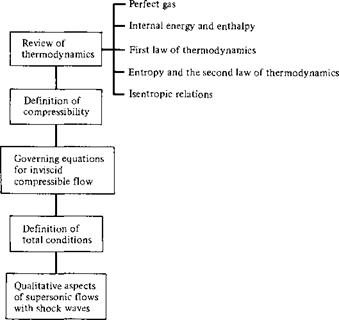Compressible Flow: Some Preliminary Aspects
With the realization of aeroplane and missile speeds equal to or even surpassing many times the speed of sound, thermodynamics has entered the scene and will never again leave our considerations.
Jakob Ackeret, 1962
7.1 Introduction
On September 30, 1935, the leading aerodynamicists from all comers of the world converged on Rome, Italy. Some of them arrived in airplanes which, in those days, lumbered along at speeds of 130 mi/h. Ironically, these people were gathering to discuss airplane aerodynamics not at 130 mi/h but rather at the unbelievable speeds of 500 mi/h and faster. By invitation only, such aerodynamic giants as Theodore von Karman and Eastman Jacobs from the United States, Ludwig Prandtl and Adolf Busemann from Germany, Jakob Ackeret from Switzerland, G. I. Taylor from England, Arturo Crocco and Enrico Pistolesi from Italy, and others assembled for the fifth Volta Conference, which had as its topic “High Velocities in Aviation.” Although the jet engine had not yet been developed, these men were convinced that the future of aviation was “faster and higher.” At that time, some aeronautical engineers felt that airplanes would never fly faster than the speed of sound—the myth of the “sound barrier” was propagating through the ranks of aviation. However, the people who attended the fifth Volta Conference knew better. For 6 days, inside an impressive Renaissance building that served as the city hall during the Holy Roman Empire, these
individuals presented papers that discussed flight at high subsonic, supersonic, and even hypersonic speeds. Among these presentations was the first public revelation of the concept of a swept wing for high-speed flight; Adolf Busemann, who originated the concept, discussed the technical reasons why swept wings would have less drag at high speeds than conventional straight wings. (One year later, the swept-wing concept was classified by the German Luftwaffe as a military secret. The Germans went on to produce a large bulk of swept-wing research during World War II, resulting in the design of the first operational jet airplane—the Me 262—which had a moderate degree of sweep.) Many of the discussions at the Volta Conference centered on the effects of “compressibility” at high subsonic speeds, that is, the effects of variable density, because this was clearly going to be the first problem to be encountered by future high-speed airplanes. For example, Eastman Jacobs presented wind-tunnel test results for compressibility effects on standard NACA four – and five-digit airfoils at high subsonic speeds and noted extraordinarily large increases in drag beyond certain freestream Mach numbers. In regard to supersonic flows, Ludwig Prandtl presented a series of photographs showing shock waves inside nozzles and on various bodies— with some of the photographs dating as far back as 1907, when Prandtl started serious work in supersonic aerodynamics. (Clearly, Ludwig Prandtl was busy with much more than just the development of his incompressible airfoil and finite-wing theory discussed in Chapters 4 and 5.) Jakob Ackeret gave a paper on the design of supersonic wind tunnels, which, under his direction, were being established in Italy, Switzerland, and Germany. There were also presentations on propulsion techniques for high-speed flight, including rockets and ramjets. The atmosphere surrounding the participants in the Volta Conference was exciting and heady; the conference launched the world aerodynamic community into the area of high-speed subsonic and supersonic flight—an area which today is as commonplace as the 130-mi/h flight speeds of 1935. Indeed, the purpose of the next eight chapters of this book is to present the fundamentals of such high-speed flight.
In contrast to the low-speed, incompressible flows discussed in Chapters 3 to 6, the pivotal aspect of high-speed flow is that the density is a variable. Such flows are called compressible flows and are the subject of Chapters 7 to 14. Return to Figure 1.38, which gives a block diagram categorizing types of aerodynamic flows. In Chapters 7 to 14, we discuss flows which fall into blocks D and F that is, we will deal with inviscid compressible flow. In the process, we touch all the flow regimes itemized in blocks G through J. These flow regimes are illustrated in Figure 1.37; study Figures 1.37 and 1.38 carefully, and review the surrounding discussion in Section 1.10 before proceeding further.
In addition to variable density, another pivotal aspect of high-speed compressible flow is energy. A high-speed flow is a high-energy flow. For example, consider the flow of air at standard sea level conditions moving at twice the speed of sound. The internal energy of 1 kg of this air is 2.07 x 105 J, whereas the kinetic energy is larger, namely, 2.31 x 105 J. When the flow velocity is decreased, some of this kinetic energy is lost and reappears as an increase in internal energy, hence increasing the temperature of the gas. Therefore, in a high-speed flow, energy transformations and temperature changes are important considerations. Such considerations come under
|
Figure 7.1 Road map for Chapter 7. |
the science of thermodynamics. For this reason, thermodynamics is a vital ingredient in the study of compressible flow. One purpose of the present chapter is to review briefly the particular aspects of thermodynamics which are essential to our subsequent discussions of compressible flow.
The road map for this chapter is given in Figure 7.1. As our discussion proceeds, refer to this road map in order to provide an orientation for our ideas.












